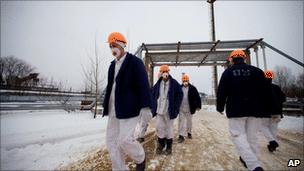Inside Chernobyl's exclusion zone
- Published

Control room of reactor 4: one of the eeriest places in the Chernobyl complex
The Chernobyl exclusion zone is still a desolate place. It is slightly larger than the 20-km (12 miles) restricted area currently in place around Fukushima in Japan.
The Japanese nuclear crisis, caused by an earthquake and tsunami, happened just before the 25th anniversary of the Chernobyl disaster, the world's worst nuclear accident.
Even after a quarter of a century, no-one in Ukraine is permitted to live within 20 miles (30km) of the plant, though a few pensioners have insisted on returning to be close to their family graves.
As you drive in, you can see abandoned villages being slowly swallowed up by the forest. People who left their homes here in 1986 had no idea they would never come back.
Body scans
But although it is desolate it is not completely empty.
There are hundreds of workers at the site who come for two-week shifts, before leaving the exclusion zone for another two weeks.
They sleep and eat in accommodation close to the plant.
Sections of the exclusion zone are known to be very dangerous, but it is the random nature of the risks that makes a visit so unnerving.
Fatal sources of radiation could be lurking under any stone.
But the risks are largely manageable.
We were allowed to enter the "sarcophagus" - the concrete-entombed reactor building.
We could not go into the ruined reactor hall, but we could go into one of the eeriest places in the complex, the control room of Reactor 4.
It is an unlit, dusty room that has been cannibalised by souvenir-hunting workers.

You can still see the desks and control panels where the men who were operating the reactor were sitting when it all went wrong.
To get this close to the heart of the disaster you have to leave all your own clothes behind and enter the site in cotton clothing, a hard hat, a simple respirator and boots, all of which you leave behind in the "dirty" side of the complex when you depart.
Your whole body is also scanned for sources of radiation before and after the visit, to make sure there is no significant change.
What happened here is the worst-case scenario that was avoided at Fukushima.
At Chernobyl, the reactor itself exploded, blowing the roof off, throwing a plume of radioactive debris into the atmosphere which drifted across Europe.
Chernobyl's reactor rods melted completely, mixing with the debris in the basement.
Risk of collapse
The radiation has been much better contained at the three damaged reactors in Japan, though the concern there is seepage into the sea.
Inside Chernobyl reactor block 25 years on
Standing very close to the newly-reinforced Chernobyl "sarcophagus" you can see that it is nonetheless in a poor state of repair. There is still a risk of collapse, and nothing can be yet done to recover the molten fuel rods.
Work has already started on a new shelter, known as the "containment".
It will look like a giant hangar that, once built, will slide over the old shelter to prevent any radioactive dust flying in the air in the event of a collapse. But the European Bank for Reconstruction and Development and the EU are struggling to raise the funds to complete the work.
Andrey Glukhov, who is part of the team building the new shelter, used to operate Reactor 4.
In fact he should have been running it on the night of the explosion, but by chance his shift was changed. We went back with him to see his home in Pripyat, a city of almost 50,000 people that is now completely abandoned.
He said that he heard the explosion in his flat, but at first the people of Pripyat did not realise how serious it had been. They were not evacuated for another 36 hours.
Close to tears, he said: "When I see the kindergarten where my children stayed, when I see the buildings where my friends used to live, some of them are no longer with us. This is emotional, this is sad."
In Japan, they will hope that the legacy of Fukushima will not last quite so long.
- Published2 February 2011
- Published2 February 2011